To Fertilize or Not to Fertilize: Soil Testing From the Bunker
Provincial recommendations are to soil test every year for annual crops, and a minimum of every three years for perennial hay crops and pasture. Ultimately, a soil test or tissue test are the best methods to determine nutrient needs of plants and to guide fertilizer and manure applications. The window of optimum nutrient levels is often narrow with a wide window of luxurious uptake which is wasteful and may result in plant toxicity symptoms. Feeding forages with unbalanced levels of minerals can present considerable consequences in animal health, so managing a balance is very important (Figure 1).
Figure 1: Schematic of plant tissue test nutrient levels and their effect on crop growth.
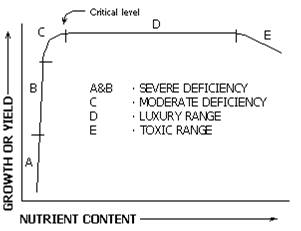
The optimum level of nutrients in plant material varies from crop to crop and the stage of maturity for each crop. Generally the macronutrients are required in higher amounts than the micronutrients. The amount of nutrients needed in the plant for optimum growth varies slightly with climate and soil type; however minimum levels needed are similar throughout many regions of North America.
For example, general guidelines in Alberta on alfalfa suggest that healthy alfalfa plants in the late bud to early bloom stage should contain a minimum of 3.0% nitrogen, 0.2% phosphorus, 1.7% potassium, and 0.2% sulphur obtained by a tissue test from the upper 15 cm of the plant (Table 1).
Table 1. Levels of nutrients in the top 15 cm of alfalfa tissue at 5 per cent bloom
Nutrient |
Low |
Sufficient per cent (%) |
High |
Nitrogen |
<3.0 |
3.0 - 5.0 |
>5.0 |
Phosphorus |
<0.20 |
0.20 - 0.70 |
>0.70 |
Potassium |
<1.70 |
1.70 - 3.80 |
>3.80 |
Calcium |
<0.25 |
0.25 - 3.0 |
>3.0 |
Magnesium |
<0.20 |
0.20 - 1.0 |
>1.0 |
Sulphur |
<0.20 |
0.20 - 0.50 |
>0.50 |
Parts per million (ppm) | |||
Boron |
<20 |
20 - 80 |
>80 |
Copper |
<5 |
30-May |
>30 |
Iron |
<20 |
20 - 250 |
>250 |
Manganese |
<20 |
20 - 200 |
>200 |
Molybdenum |
<0.5 |
0.5 - 5.0 |
>5.0 |
Zinc |
<20 |
20 - 70 |
>70 |
Recommendations from the University of Cornell suggest the optimum ranges are slightly higher for example, where tissue test levels for nitrogen in alfalfa at early bloom should be between 3.75 to 5.50% by weight, 0.25 to 0.7% phosphorous, 2 to 3.5% potassium, and 0.25 to 0.5% sulfur (Table 2). In this example, one tonne of alfalfa hay cut at early bloom would contain 75 to 110 kg of nitrogen, 5 to 14 kg of phosphorus, 40 to 70 kg of potassium, and 5 to 10 kg sulfur.
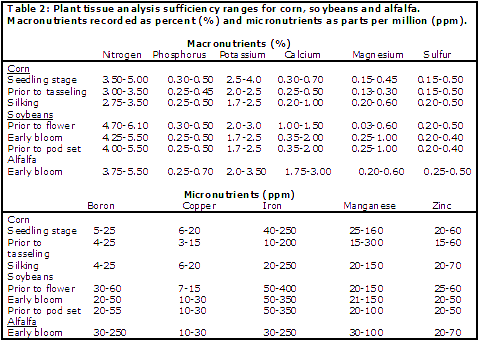
Source: Cornell University Extension Service.
Similarly, research in Utah suggests tissue tests just prior to first cut should observe the following minimum nutrient thresholds to maintain optimum production: 0.26% phosphorous, 2.0% potassium, 1.3% calcium, 0.25% Magnesium, 0.26% sulfur, 21 ppm zinc, 30 ppm iron, 25 ppm manganese, 5 ppm copper, 30 ppm boron and 1 ppm molybdenum.
Finally, Dr. Loraine Bailey of Agriculture and Agri-food Canada in Brandon demonstrated the effect of optimum plant nutrient levels in alfalfa yield and quality in Southwestern Manitoba (Tables 3,4,5). Plant phosphorus levels between 0.22% to 0.25%, potassium levels between 2.5% and 3.2%, and sulfur levels 0.23% provided the highest yield and protein.
Table 3: Effect of phosphorus application on alfalfa yield, phosphorus content and protein.
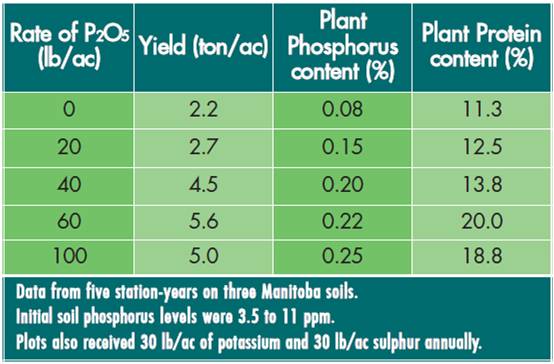
Source: Bailey, AAFC.
Table 4: Effect of potassium application on alfalfa yield, potassium content and protein.
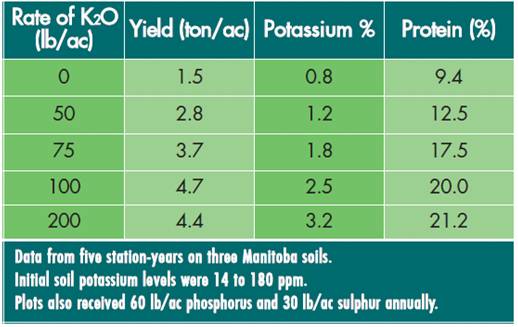
Source: Bailey, AAFC.
Table 5: Effect of sulfur application on alfalfa yield, sulfur content and protein.
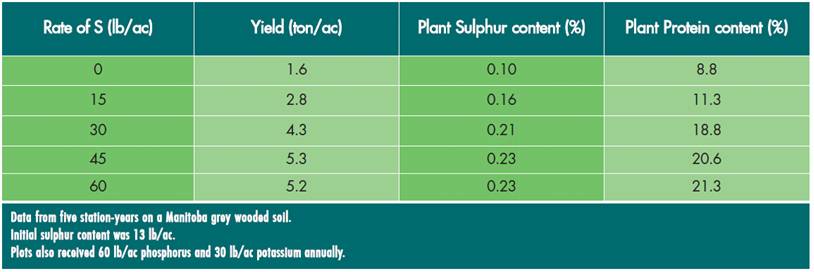
Source: Bailey, AAFC.
Tissue Test vs. the Feed Test?
There may be another option if you cannot justify the time to sample your hay field prior to cutting. Like a tissue test, a feed test on harvested bales examines the nutrient levels of the hay to determine the additional minerals required when feeding the hay to livestock. The accuracy of the nutrient levels in the feed tests are directly linked to the plant material included in the cored sample submitted by the producer. These often contain all plant parts with a range of plant maturity levels typical in a mixed hay field. This variability explains in part the range of nutrient levels found over 6 years of feed test data collected from across Manitoba between 2000 and 2005 (Table 6). For example, the phosphorous levels in alfalfa/grass mixes averaged 0.20% plus or minus nearly 0.20% - certainly too wide a variation to use an average safely, and underscoring the need to test your feed from both a nutrient removal standpoint and livestock nutrition.
We must also recognize that feed test samples collected do not follow the sampling guidelines used in tissue tests which are calibrated for specific plant parts (top 6 inches) and stages of maturity (early bloom in alfalfa). For this reason, a feed test should only be used as a guideline and must be followed up with a tissue or soil test to determine the actual deficiency and amount of fertility to apply.
Table 6: Average, minimum, and maximum nutrient removal rates based on province wide summary data of Manitoba feed test data collected between 2000 and 2005.
Proportion of fertilizer removed (% of Dry Matter or ppm) | |||||||
Feed |
Alfalfa |
Alfalfa/grass |
Grass/Alfalfa |
Native Hay |
Barley GF |
Oat GF | |
N (%) |
Min |
1.23% |
0.70% |
0.94% |
0.62% |
0.80% |
0.53% |
Max |
4.77% |
4.19% |
4.51% |
2.51% |
3.70% |
3.33% | |
AVG |
3.25% |
2.58% |
2.11% |
1.52% |
1.82% |
1.65% | |
P (%) |
Min |
0.09% |
0.05% |
0.08% |
0.06% |
0.08% |
0.04% |
Max |
0.45% |
0.40% |
0.44% |
0.29% |
0.46% |
0.55% | |
AVG |
0.23% |
0.20% |
0.19% |
0.12% |
0.25% |
0.23% | |
K (%) |
Min |
0.59% |
0.54% |
0.75% |
0.41% |
0.45% |
0.41% |
Max |
4.05% |
3.33% |
3.72% |
3.14% |
3.57% |
4.06% | |
AVG |
2.24% |
1.99% |
1.93% |
1.30% |
1.78% |
2.03% | |
Ca (%) |
Min |
0.41% |
0.20% |
0.25% |
0.26% |
0.12% |
0.06% |
Max |
2.89% |
2.62% |
1.58% |
1.08% |
1.15% |
0.90% | |
AVG |
1.59% |
1.19% |
0.81% |
0.54% |
0.45% |
0.33% | |
Mg (%) |
Min |
0.15% |
0.07% |
0.08% |
0.12% |
0.08% |
0.07% |
Max |
0.67% |
0.66% |
0.60% |
0.51% |
0.57% |
0.49% | |
AVG |
0.35% |
0.30% |
0.24% |
0.27% |
0.25% |
0.22% | |
Mn (ppm) |
Min |
0.002% |
0.000% |
0.003% |
0.004% |
0.001% |
0.001% |
Max |
0.006% |
0.010% |
0.004% |
0.027% |
0.004% |
0.012% | |
AVG |
0.004% |
0.004% |
0.003% |
0.010% |
0.003% |
0.003% | |
Zn (ppm) |
Min |
0.000% |
0.000% |
0.001% |
0.002% |
0.000% |
0.001% |
Max |
0.003% |
0.004% |
0.002% |
0.003% |
0.003% |
0.003% | |
AVG |
0.002% |
0.002% |
0.002% |
0.002% |
0.002% |
0.002% | |
Cu (ppm) |
Min |
0.000% |
0.000% |
0.000% |
0.000% |
0.000% |
0.000% |
Max |
0.002% |
0.001% |
0.001% |
0.001% |
0.001% |
0.001% | |
AVG |
0.001% |
0.001% |
0.000% |
0.000% |
0.000% |
0.000% | |
Fe (ppm) |
Min |
0.005% |
0.002% |
0.005% |
0.007% |
0.004% |
0.004% |
Max |
0.033% |
0.077% |
0.030% |
0.027% |
0.066% |
0.050% | |
AVG |
0.016% |
0.012% |
0.011% |
0.014% |
0.019% |
0.011% | |
Mb (ppm) |
Min |
0.000% |
0.000% |
0.000% |
0.000% |
0.000% |
0.000% |
Max |
0.001% |
0.001% |
0.001% |
0.000% |
0.001% |
0.001% | |
AVG |
0.000% |
0.000% |
0.000% |
0.000% |
0.000% |
0.000% | |
Na (%) |
Min |
0.01% |
0.01% |
0.01% |
0.04% |
0.01% |
0.01% |
Max |
0.42% |
0.28% |
0.08% |
0.41% |
0.95% |
1.22% | |
AVG |
0.05% |
0.03% |
0.02% |
0.08% |
0.17% |
0.30% | |
NaCl |
Min |
0.03% |
0.03% |
0.03% |
0.03% |
0.03% |
0.03% |
Max |
0.83% |
0.72% |
0.16% |
1.04% |
1.82% |
3.10% | |
AVG |
0.13% |
0.08% |
0.06% |
0.15% |
0.44% |
0.77% | |
*Bodycote nitrogen data based on 6.25 x crude protein.
*Sulfur content was not included in original Bodycote data set because sulfuric acid is used during the mineral extraction process.
The Bottom Line
Although not the most accurate indicator, your feed test can be an excellent substitute to identify fields in need of some fertilizer attention. Since all feed being sold or used for feed is usually tested, this needn’t be an additional cost to your operation.
References
Alfalfa Management Guide. Undersander, D., Martin,
Bailey, L. 1999. Agriculture and Agri-Food Canada.
Canadian Fertilizer Institute. 2001. Nutrient Uptake and Removal by Field Crops.
Cardon, G. E., Barnhill, J., Pace, M., Israelsen, C., Miner, D., Greenhalgh, L.,
Banks, S., Shao, M. Rothlisberger, D. Olsen S., Hole, P. 2009. Micro-nutrients in alfalfa production: Is there need/opportunity for cost effective management? Western Nutrient Management Conference. 2009. Vol. 8. Salt Lake City, UT.
Cosgrove, D., Kelling, K., Schmitt, M., Wedburg, J., Becker, R., Grau, C., Doll, J., and Rice, M.E. 1994. Pub. By American Society Of Agronomy 51 pp.
Knight, J. Ketterings, Q., Kingston, J., Czymmek, K., 2010. Agronomy Fact Sheet Series Fact Sheet 55, http://nmsp.cals.cornell.edu
Manitoba Agriculture, Food and Rural Initiatives, 2009. Manitoba Average Forage Mineral Concentration
McKenzie, R.C., McKenzie, R.H. and Kryzanowski, L. 1999. Fertilizer requirement of irrigated alfalfa. Alberta Agricultural Research Institute. Project 94M626. 60 pp.
